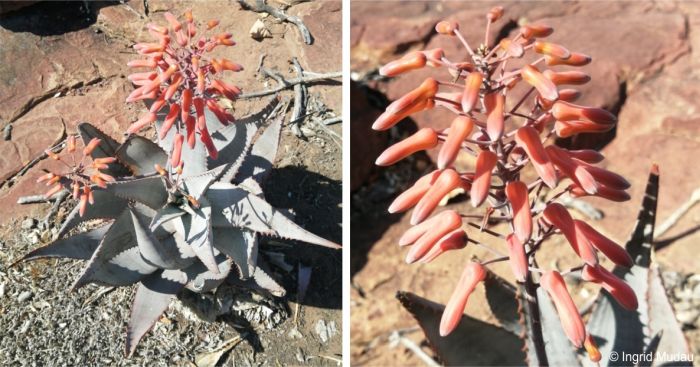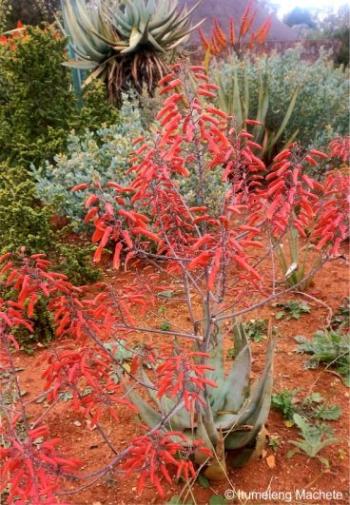Aloe chabaudii
Aloe chabaudii Schönland
Family: Asphodelaceae
Common names: Chabaud’s aloe, grey aloe, Dwala aloe (Eng.); grysaalwyn (Afr.); inhlaba (siSwati, isiZulu); inkalane (isiZulu); mangani (Tswana;) tshikhopha (Venda)
Introduction
Grey aloe is a water-wise garden plant which can be planted in a rockery garden and flower beds to add colour during the winter season. It is a stemless aloe, with conspicuous bright orange-red flowers and grey green leaves arranged in attractive rosettes. Not only is it a beautiful winter-flowering plant, but it also has medicinal properties.

Description
Description
Aloe chabaudii is a stemless, perennial succulent plant with grey-green upright leaves arranged in a rosette, and forms dense clusters that grow about 300 to 500 mm tall, up to 1 m high including the inflorescence. The leaves have serrated margins with short pointy thorns at the edges. The colour of the leaves may change to pinkish red when the plant experiences dry periods. The leaves of mature plants have faint thin lines on both sides while young plants have white spots on both sides of their leaves. Aloe chabaudii inflorescences are typically much-branched and rounded to spreading and consist of cone-shaped clusters, about 160-100 mm long, made up of bright reddish or pinkish tubular flowers, 35-40 mm long. The inflorescences appear in midwinter, between June and July. The small, brown to black, angled seeds are released from capsules that dry up and split open. The mature seeds have a narrow, noticeable translucent or white wing. The wing helps the wind to easily disperse the seeds.
Specimens of yellow and orange flowering Aloe chabaudii have been collected in both Zimbabwe and Malawi. Aloe chabaudii var. mlanjeana and Aloe chabaudii var.verekeri are two varieties that are described. Aloe chabaudii var. verekeri is no longer recognised, it was thought to occur in Zimbabwe and was differentiated by its olive green leaves with hooked thorns on the margins, however, plants with these characteristics were found throughout the natural range. Aloe chabaudii var. mlanjeana occurs in Malawi and can be differentiated by its bright green leaves with white margins and shortened inflorescences.
Aloe chabaudii may be mistaken for Aloe globuligemma when not in bloom. Aloe chabaudii’s leaves are more grey and less recurved than those of Aloe globuligemma, and compared to Aloe globuligemma, this plant is often smaller. The lateral branches of the inflorescences in Aloe globuligemma are carried horizontally and the latter species bears globular, club-shaped, deep pinkish blooms that are borne almost entirely vertically.

Conservation Status
Status
According to the Red List of South African Plants, Aloe chabaudii var. chabaudii is assessed as Least Concern (LC) which means that is not yet threatened and this is due to its widespread occurrence. It also listed on CITES appendix II and this means that while the plant is not in danger of going into extinction right now, it might do so if international trading is not strictly regulated.
Distribution and habitat
Distribution description
Aloes can be found in various vegetation types in South Africa, including arid and semi-arid Karoo regions, winter rainfall fynbos, grassland and savanna. Some also grow in high-rainfall forests. They are not endemic to South Africa, they also occur in east, central and west African countries, Madagascar, Socotra, the Arabian Peninsula and the Mascarene and other Western Indian Ocean Islands. Aloe chabaudii naturally occurs from Tanzania and Democratic Republic of Congo to the north-eastern parts of South Africa. In South Africa they are widespread in Limpopo, Mpumalanga and KwaZulu-Natal. Aloe chabaudii also grows in Eswatini, Zimbabwe and Zambia. This species is found in grassland, bushveld and open woodland, in shallow soil among rocks.

Derivation of name and historical aspects
History
The origin of the genus name Aloe is uncertain, but it is commonly thought to be derived from the Arabic alloch or alloeh, a vernacular term for plants in this medicinally utilized genus; alternatively, the Greek word aloë, which describes the dried juice of aloe leaves. Aloe chabaudii was named after John A. Chabaud, a plant grower from Port Elizabeth, South Africa. The type specimen that was used for the original scientific description of this species flowered in his garden.
Ecology
Ecology
Aloes grow in dry areas and their succulent leaves assist them in surviving long periods of drought. The thorns on the margins of their leaves and the bitter sap stored in their leaves help prevent some of the herbivores from eating them. Aloe flowers, more especially the bright, tubular ones, contain sweet nectar which provide some insects and birds with food, and they pollinate the flowers while feeding on the nectar. However, these flowers can also be targeted by nectar thieves that can end up destroying the inflorescence.

Uses
Use
The sap and pulp of some species of Aloe is used in health drinks, nutritional supplements, cosmetics, and skin care items. The leaves are also used to treat a variety of diseases as they have antioxidant, anti-inflammatory, and antibacterial properties.
Grey aloe can be used in a rockery or waterwise flower bed as a focal plant. Its red flowers add beautiful winter colour to a sunny flower bed. It can also be planted as a pot plant that can liven up a dull spot near the house or in the garden. Its leaves are eaten by wild animals, and they are also used for snuff.

Growing Aloe chabaudii
Grow
Aloe chabaudii can be propagated easily by seeds, and germination can happen within a week if the conditions are favourable. Seeds must be harvested as soon as the dry seed pod opens. Seeds can be sown in spring or summer, between August and February, in a well draining medium. A mixture of 50% washed river sand and 50% sifted compost can be used to sow the seed. Lightly cover the sown seeds with sand to secure them and place the trays in a warm, shady spot for germination. Transplanting can be done as soon as the third true leaf appears, this usually happens in a period of a 12 months. Division is another method that can be used to propagate grey aloe, it normally produces suckers and they can be divided and planted as individual plants. The same mixture of 50% sand and 50% sifted compost can be used. Established plants do not require a lot of water. Water them twice a week in summer and once every two weeks in winter, always check moisture levels before watering. Be careful not to give them too much water as this might trigger root rot.
References
- CITES. Aloe chabaudii. https://cites.org/eng/gallery/species/other_plant/Aloe_chabaudii.html. Accessed on 22/02/2024.
- Glen, H.F. & Hardy, D.S. 2000. Aloaceae (First part): Aloe. In: G. Germishuizen (ed.), Flora of Southern Africa, Vol. 5, Part 1, Fasc. 1: 1–159. National Botanical Institute, Pretoria.
- Grace, O.M., Klopper, R.R., Figueiredo, E. & Smith, G.F. 2011. The aloe names book. Strelitzia 28: i–viii.; 1–232. South African National Biodiversity Institute, Pretoria and the Royal Botanic Gardens, Kew.
- Kativu, S. 2001. Asphodelaceae. In: G.V. Pope (ed). Flora Zambesiaca 12 (Part 3): 25-48. Royal Botanic Gardens, Kew.
- Klopper, R. & Smith, G. 2010. Aloe L. (Asphodelaceae). PlantZAfrica. Online. http://pza.sanbi.org/aloe-genus[
- Mtshali, H. & Von Staden, L. 2018. Aloe chabaudii Schönland var. chabaudii. National Assessment: Red List of South African Plants version. Accessed on 2024/02/22.
- Pooley, E. 2005. A field guide to wild flowers KwaZulu-Natal and the eastern region. The Flora Publications Trust, Durban.
- Soethoudt, A. 2023. Observation of Aloe chabaudii, Mookgopong, Limpopo. iNaturalist. Online. https://www.inaturalist.org/observations/162286656.
- Van Wyk, B. & Smith, G.F. 1996. Guide to the aloes of South Africa. Briza Publications, Pretoria.
- Wadley, L., Willemse, L., Baytopp, K., Swart, J., Heymans, J. Tarboton, W. & Tarboton, M. 2021. Wild Flowers of the Waterberg. Mapula Trust.
Credits
Itumeleng Machete and Thabang Molaudzi
Pretoria National Botanical Garden
March 2024
Acknowledgements: the authors thank Ms. Ingrid Mudau, Pitta Joffe, Geoff Nichols and Alex Soethoudt for providing the pictures for this article.
Plant Attributes:
Plant Type: Succulent
SA Distribution: KwaZulu-Natal, Limpopo, Mpumalanga
Soil type: Sandy, Loam
Flowering season: Winter
PH: Acid, Neutral
Flower colour: Red, Pink, Orange
Aspect: Full Sun
Gardening skill: Easy
Special Features:
Horticultural zones










Rate this article
Article well written and informative
Rate this plant
Is this an interesting plant?
Login to add your Comment
Back to topNot registered yet? Click here to register.